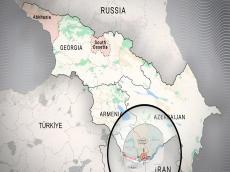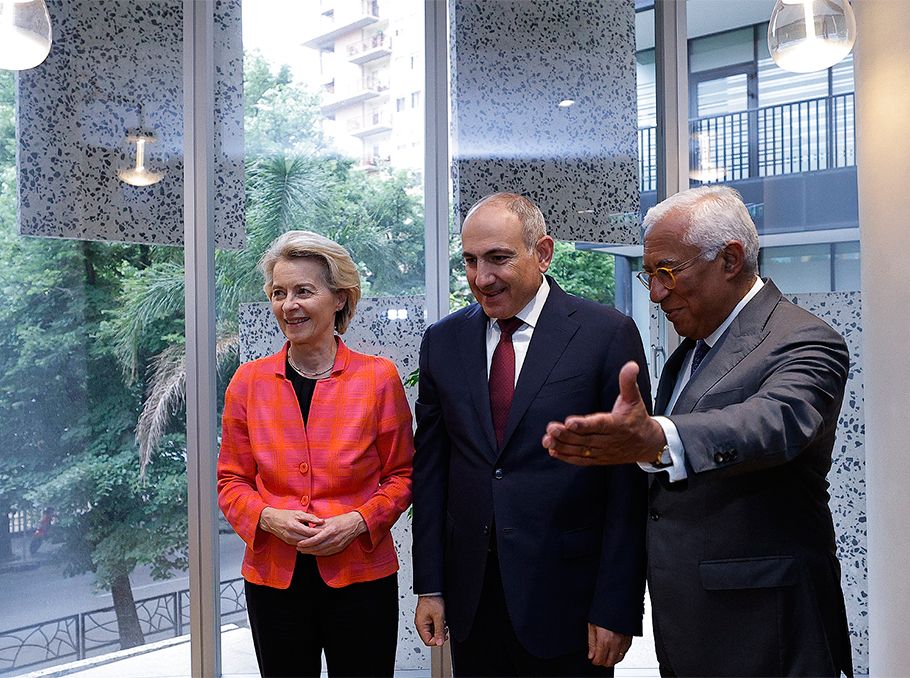|
|
TODAY.AZ / Analytics
South Caucasus in focus: Peace, Corridors and Competing Powers
15 July 2025 [13:47] - TODAY.AZ

Since the end of the conflict and Armenian occupation of Garabagh, the first ever bilateral meeting between Azerbaijani President Ilham Aliyev and Armenian Prime Minister Nikol Pashinyan in Abu Dhabi in July 2025 marks a significant step forward in the search for a comprehensive peace agreement between the two South Caucasus neighbours. Facilitated under the diplomatic auspices of the United Arab Emirates, a rising mediator in global conflicts, the talks have generated cautious optimism among regional watchers and international stakeholders alike. Central to the discussions is the long-disputed Zangazur Corridor, a proposed transport route that has drawn in not only Azerbaijan and Armenia, but also the United States, Russia, Iran, Türkiye, and the European Union.
At its core, the Zangazur Corridor represents more than a logistics route linking Azerbaijan to its exclave of Nakhchivan through southern Armenia. It is a strategic artery that could reshape connectivity across Eurasia, reinforce energy security for Europe, and redefine power alignments in the post-Soviet space. In Abu Dhabi, for the first time, the Azerbaijani and Armenian leaders discussed third-party management of the corridor, most notably, a US proposal to control the corridor for 100 years, a move that underscores Washington’s growing interest in countering both Russian and Iranian influence in the South Caucasus.
The Zangazur Corridor, if realised, would dramatically shorten trade routes between Central Asia and Europe via the Caspian, South Caucasus, and Türkiye. For Armenia, however, the corridor has become a symbol of lost leverage and a domestic political liability, which Pashinyan’s government has tried to rebrand as a "transit route under Armenian sovereignty", resisting the "corridor" terminology altogether.
After the bilateral Abu Dhabi meeting, the reported American proposal for long-term corridor oversight reflects a deepening of security measures. According to diplomatic leaks, the US offered to manage the Zangazur route as an international transport corridor under a 100-year administration model, similar to the historical Panama or Suez Canal arrangements. The proposal is driven by a single factor: ensuring the uninterrupted flow of goods and energy from Central Asia and the Caspian to European markets.
This overture, however, risks intensifying the Russia-Iran alignment, both of which view the corridor through the prism of geostrategic encirclement. Russia’s traditional role as regional arbiter has diminished following its military overreach in Ukraine, but it still maintains military bases in Armenia. Moscow views the US-led control of the Zangazur Corridor as a direct threat to its "near abroad" and influence over Yerevan. Iran, meanwhile, sees any extraterritorial corridor through Armenian territory as a red line, fearing it would cut off its access to the Caucasus and enable a permanent NATO-aligned presence on its northern border. Despite all this, from both the Iranian and Western perspectives, the significance of the Zangazur Corridor is not limited to Eurasia alone; it also creates a favourable environment for the safe use of the corridor by Russia and Iran (for civilian commercial purposes) in the future.
The Brussels Pivot: Pashinyan’s Calculations and Macron’s Agenda
Against this backdrop, Armenian Prime Minister Nikol Pashinyan's recent visit to Brussels and his private meetings with French President Emmanuel Macron and EU leaders signal Yerevan’s westward shift. Publicly, the visit was framed as an effort to deepen EU-Armenia political and economic cooperation.

However, behind closed doors, Pashinyan reportedly sought guarantees of European support for Armenia’s sovereignty, territorial integrity, and resistance to "corridor language" in any future agreement with Azerbaijan.
France, under Macron, has emerged as Armenia’s most vocal European backer, supplying limited arms, training, and consistent diplomatic support. However, Macron’s agenda is not solely humanitarian. France sees the South Caucasus as a front line in the wider geopolitical contest between Western liberal democracies and revisionist autocracies, especially given its deteriorating ties with Türkiye and desire to constrain Russian influence. For Macron, backing Armenia also offers a way to reassert French influence in a region where its presence has traditionally been symbolic at best.
There are, however, limits to this strategy. Brussels remains reluctant to militarise its engagement and is cautious about alienating Azerbaijan, a critical energy partner for the EU. Pashinyan's overtures to Macron and European leaders thus walk a fine line between seeking protection and not pushing the EU into open confrontation with Baku or Ankara. The EU is more likely to invest in connectivity and peacebuilding projects than support Armenia in resisting transit arrangements that align with broader regional economic integration.
Peace by the end of 2025? Realistic or wishful thinking?
The most immediate question is whether a peace agreement between Azerbaijan and Armenia is achievable by the end of 2025. Optimists argue that the recent flurry of diplomacy points to a narrowing window of opportunity. The withdrawal of Russian peacekeepers, the stabilisation of borders, and the relative calm since late 2023 have created conditions for finalising a treaty that normalises relations, delimits the border, and opens transport links.
However, substantial hurdles remain. First, domestic political resistance in Armenia, fuelled by nationalist opposition and diaspora lobbying, continues to pressure Pashinyan against making concessions on Zangazur. In particular, the tensions between the Church and the Pashinyan government, the mobilisation of pro-Russian oligarch Samvel Karapetyan and his pro-Republican Party entourage against the authorities, and the artificial escalation of unrest in the country are all obstacles preventing Armenia from taking direct and decisive action.
Second, external interference, whether through Iran’s threats, Russia’s passive-aggressive manoeuvring, or France’s moral posturing, could derail progress. Third, lingering mistrust between Baku and Yerevan, particularly regarding the implementation of agreements and security guarantees, continues to haunt negotiations.
Nonetheless, the broader regional and global incentives for peace are strong. The South Caucasus stands at the intersection of multiple transport, energy, and communication projects that hinge on stability. Azerbaijan has positioned itself as a reliable energy partner and logistical hub; Armenia, though late to pivot, now sees the economic and political benefits of breaking out of its regional isolation. If the US and EU can synchronise their approaches, and if Iran and Russia are kept at bay diplomatically, a peace deal is achievable by early 2026, or perhaps even the end of 2025, but only if compromises are reached on the Zangazur Corridor and border recognition.
URL: http://www.today.az/news/analytics/260653.html
 Print version
Print version
Connect with us. Get latest news and updates.
See Also
- 04 November 2025 [14:05]
South Caucasus at civilizational crossroads: between memory and modernity - 04 November 2025 [08:30]
Technological power defines sovereignty: President Aliyev’s vision for digital Azerbaijan - 03 November 2025 [08:30]
Azerbaijan-China partnership enters new phase with renewable energy focus - 01 November 2025 [13:49]
From Qaraba? to Kashmir: How shared struggles unite Pakistan, Azerbaijan - 01 November 2025 [08:30]
Azerbaijan unites clean energy and innovation in Alat Free Economic Zone - 30 October 2025 [20:14]
Distorted narratives risk reversing South Caucasus peace progress - 30 October 2025 [08:30]
President Aliyev’s reconstruction strategy reshapes liberated lands into engines of growth - 29 October 2025 [14:08]
Türkiye at 102: Century of resilience, renewal, and emerging power - 29 October 2025 [08:30]
Azerbaijan’s industrial push builds non-oil future through regional growth - 27 October 2025 [20:31]
Armenia’s struggle for post-conflict future meets Church resistance
Most Popular
 Azerbaijan and Ukraine discuss cooperation in healthcare industry and medicine production
Azerbaijan and Ukraine discuss cooperation in healthcare industry and medicine production
 Iran’s nuclear efforts aimed at meeting national needs, not building weapons — President Pezeshkian
Iran’s nuclear efforts aimed at meeting national needs, not building weapons — President Pezeshkian
 Who stole the data on rare earths in Karabakh?
Who stole the data on rare earths in Karabakh?
 UNEC and BFSU deepen partnership in language and economics
UNEC and BFSU deepen partnership in language and economics
 Justice Ministry and SMBDA hold meeting with business associations
Justice Ministry and SMBDA hold meeting with business associations
 North Macedonia holds second round of local elections
North Macedonia holds second round of local elections
 Pakistan reopens Afghan border as ceasefire holds
Pakistan reopens Afghan border as ceasefire holds
